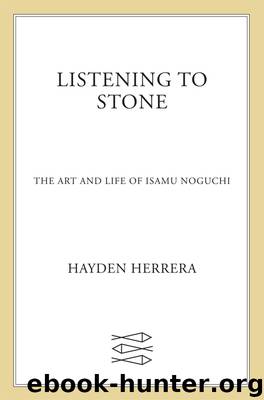Listening to Stone by Hayden Herrera

Author:Hayden Herrera
Language: eng
Format: epub
ISBN: 9780374712969
Publisher: Farrar, Straus and Giroux
Noguchi’s bridge railing for Hiroshima, Tsukuru (To build), 1952
At summer’s end Noguchi and Yamaguchi moved on to New York, where they both met with critic Aline B. Louchheim, who was writing a piece on Noguchi for The New York Times. Noting Noguchi’s pleasure in working on public projects in Japan, Louchheim observed: “The sculptor has broken from the imprisonment of a solitary studio. His new place of work is the world.”28 Noguchi once wrote that during this eight-month sojourn in Manhattan, he was “filling in the time while Yoshiko worked.”29 In fact he was working on two projects. One was a playground for the United Nations Headquarters in Manhattan, a commission that had come from his friend Audrey Hess, wife of the critic Thomas B. Hess, who had written such a positive and insightful article about Noguchi for Art News in 1946. The other project was an interior plaza or sculpture garden on the ground floor of the dazzling new Lever House, a glass-fronted office building on Park Avenue designed by Gordon Bunshaft, chief architect at Skidmore, Owings and Merrill.
Audrey Hess had approached Noguchi about the playground commission before he left for Japan to work on the Reader’s Digest garden. By June 1951 Noguchi, still in Tokyo, was working on his concept for the playground and was conferring by mail with architect Julian Whittlesey, with whom he was collaborating. On August 7, back in the United States, Noguchi met with the project’s sponsors, including Audrey Hess, Mrs. John D. Rockefeller, and Mrs. David Levy (Hess’s aunt). The sponsoring group raised $75,000 to pay for a 100-by-140-foot playground to be built northeast of the UN building.
Noguchi designed a play landscape with a grotto, a jungle gym, a multitiered structure for climbing and sliding, a wading pool, swings, and triangular hills in bright colors. There were tunnels and winding paths and round hollows filled with sand. As always, there were mounds. Both the UN’s architect, Wallace K. Harrison, and the UN plan director Glenn Bennett were enthusiastic, but Robert Moses, the man who had thwarted Noguchi’s Play Mountain, was not impressed: “If they want to build it, it’s theirs, but I’m not interested in that sort of playground,” he said. “If they want us to operate it, it’s got to be on our plans. We know what works.”30 Noguchi heard later that Moses had threatened not to put safety railings along the East River if the playground was built.31 Not surprisingly, the UN succumbed to Moses’s pressure and agreed to build instead a conventional playground of the type that Moses approved.
The rejected playground became a cause célèbre in art circles. When in mid-April the Museum of Modern Art exhibited the plaster model together with some of Whittlesey’s drawings, it described the UN playground as “the most creative and imaginative play area yet devised.”32 In a short piece about it in the April issue of Art News, Thomas Hess extolled the playground’s beauty and its integration of modern art and daily life. “Perhaps
Download
This site does not store any files on its server. We only index and link to content provided by other sites. Please contact the content providers to delete copyright contents if any and email us, we'll remove relevant links or contents immediately.
Cecilia; Or, Memoirs of an Heiress — Volume 2 by Fanny Burney(31913)
Cecilia; Or, Memoirs of an Heiress — Volume 3 by Fanny Burney(31898)
Fanny Burney by Claire Harman(26565)
We're Going to Need More Wine by Gabrielle Union(19004)
Plagued by Fire by Paul Hendrickson(17372)
All the Missing Girls by Megan Miranda(15787)
Cat's cradle by Kurt Vonnegut(15262)
Bombshells: Glamour Girls of a Lifetime by Sullivan Steve(14024)
For the Love of Europe by Rick Steves(13637)
Leonardo da Vinci by Walter Isaacson(13238)
4 3 2 1: A Novel by Paul Auster(12333)
The remains of the day by Kazuo Ishiguro(8896)
Adultolescence by Gabbie Hanna(8889)
Note to Self by Connor Franta(7646)
Diary of a Player by Brad Paisley(7521)
Giovanni's Room by James Baldwin(7256)
What Does This Button Do? by Bruce Dickinson(6171)
Ego Is the Enemy by Ryan Holiday(5351)
Born a Crime by Trevor Noah(5337)
